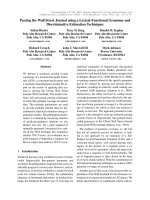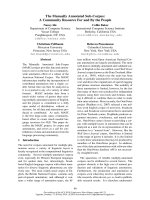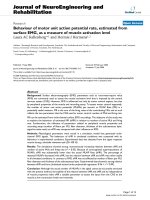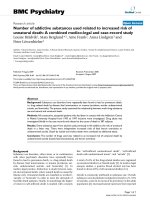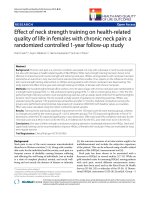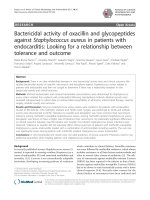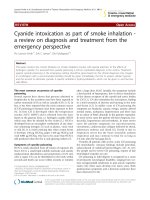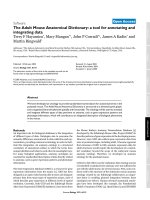The behaviour of hyaluronan solutions in the presence of Hofmeister ions: A light scattering, viscometry and surface tension study
Bạn đang xem bản rút gọn của tài liệu. Xem và tải ngay bản đầy đủ của tài liệu tại đây (1.34 MB, 8 trang )
Carbohydrate Polymers 212 (2019) 395–402
Contents lists available at ScienceDirect
Carbohydrate Polymers
journal homepage: www.elsevier.com/locate/carbpol
The behaviour of hyaluronan solutions in the presence of Hofmeister ions: A
light scattering, viscometry and surface tension study
T
⁎
Lenka Musilováa,b, Věra Kašpárkováb,c, Aleš Mráčeka,b, , Antonín Minaříka,b, Martin Minaříka
a
Tomas Bata University in Zlín, Faculty of Technology, Department of Physics and Material Engineering, nám. T.G. Masaryka 5555, 760 01 Zlín, Czech Republic
Centre of Polymer Systems, Tomas Bata University in Zlín, nám. T.G. Masaryka 5555, 760 01 Zlín, Czech Republic
c
Tomas Bata University in Zlín, Faculty of Technology, Department of Fat, Surfactant and Cosmetics Technology, nám. T.G. Masaryka 5555, 760 01 Zlín, Czech Republic
b
A R T I C LE I N FO
A B S T R A C T
Keywords:
Hyaluronan
Hofmeister effect
Conformation
Surface tension
Hydrodynamic diameter
Viscosity
Dynamic light scattering (DLS), viscosity and surface tension (SFT) measurements were used to characterize
influence of salts containing ions of Hofmeister series (Na2SO4, (NH4)2SO4, NaSCN, NH4SCN and NaCl) on the
behaviour of hyaluronan in diluted solutions at a temperature range of 15–45 °C. The results of the study showed
that chaotropic and kosmotropic ions notably influenced the folding and unfolding of hyaluronan coils due to
interactions between a respective ion and hydrophilic or hydrophobic patches present in the backbone of the
polymer chains. This was mainly proved by viscosity and light scattering measurements. The temperature dependence of the hydrodynamic diameter of the hyaluronan coil determined by DLS demonstrated that combinations of chaotropic and kosmotropic ions in one salt (NaCl, NaSCN and (HN4)2SO4) can stabilize the size of the
coil in a wide range of temperatures. Tensiometry measurements indicated that certain types of ions present in
the solution caused an unfolding of the hyaluronan coils, leading to a decrease of SFT.
1. Introduction
The interactions of ions with polymers in diluted solutions are
challenging phenomena in colloid and interface sciences. The first
systematic study dealing with the interactions of ions with rigid polymers, namely proteins, was published by Franz Hofmeister in 1888
(Baldwin, 1996; Hofmeister, 1888; Kunz, Henle, & Ninham, 2004). His
pioneering research resulted in an arrangement of ions in a series with
specific properties in terms of protein precipitation, and in the classification of ions into salting-in (chaotropic) and salting-out (kosmotropic) systems. However, theories related to principles and explanations of the described phenomena are still discussed, and
interpretations of data on interactions between the ions and macromolecules, which are not rigid but exist as a statistic coil, are still not
fully explained and are considered even more complicated than those
on rigid proteins (Zhang & Cremer, 2006). Recently, the research
groups of Cremer and Jungwirth published feature article (Okur et al.,
2017) about ion-specific effects of Hofmeister ions on proteins and their
biological function. The main message of the work (Okur et al., 2017)
consists in identification of dominant role of strong/weak ion hydration, and binding affinity of the ion to charged side-chain group or to
hydrophobic backbone of polymer chain. Okur et al. show experimental
data and molecular dynamics simulations supporting their hypotheses.
Moreover, the specific behaviour of ions in water in the absence of
polymers, such as hydration, has been extensively studied both experimentally and theoretically (Barthel & Krestov, 1991; Bernal &
Fowler, 1933; Franck, 1960; Heinzinger & Vogel, 1974; Hribar,
Southall, Vlachy, & Dill, 2002; Hummer, Pratt, & García, 1998; Marx,
Sprik, & Parrinello, 1997; Meyer & Pontikis, 1991; Payne, Teter, Allan,
Arias, & Joannopoulos, 1992; Samoilov, 1957, 1972; Vlachy et al.,
2009), and these interactions must also be taken into consideration
under theoretical explanations of interactions of macromolecules with
ions of the Hofmeister series.
The order of ions in the original Hofmeister series and their related
properties are illustrated in Fig. 1. The left side of the series is comprised of kosmotropes, while chaotropes are on the right side. The terms
“kosmotropic” and “chaotropic” ion/behaviour are related to the capability of a particular ion to “make” or “break” a water structure
(Kropman & Bakker, 2003, 2004; Omta, Kropman, Woutersen, &
Bakker, 2003a, 2003b). It is also generally accepted that these effects
are more prominent for anions than for cations. However, with regard
to a deeper understanding of the influence of ions on the behaviour of
polymers, with the exception of proteins, the published data is rather
scarce, concentrating prevailingly on thermoresponsive polymers
⁎
Corresponding author at: Tomas Bata University in Zlín, Faculty of Technology, Department of Physics and Material Engineering, nám. T.G. Masaryka 5555, 760
01 Zlín, Czech Republic.
E-mail address: (A. Mráček).
/>Received 8 October 2018; Received in revised form 27 January 2019; Accepted 11 February 2019
Available online 19 February 2019
0144-8617/ © 2019 Elsevier Ltd. All rights reserved.
Carbohydrate Polymers 212 (2019) 395–402
L. Musilová, et al.
Fig. 1. Typical ordering of the Hofmeister ion series (Zhang & Cremer, 2006).
attractions must be considered, while interactions of the hydrophilic
parts of the chain are influenced by hydration forces (Faraudo &
Bresme, 2005). A comprehensive study summarising the behaviour of
NaHy in diluted polymer solutions was published by Cowman and
Matsuoka (Cowman & Matsuoka, 2005). Here, however, the behaviour
of NaHy in a saline solution was mainly discussed, as this solvent, resembling in vivo physiological conditions, is mostly used for NaHy
dissolution. Interactions of NaHy with other types of ions have been
investigated only rarely, and a publication by Mracek et al. (2008) is an
example. The influence of Hofmeister ions on polysaccharides, including NaHy, was also investigated by Tatini et al. (2017), who employed rheology and differential scanning calorimetry (DSC) for this
purpose. The authors, however, used a more concentrated polymer
solution (1%, w/w), which can hardly be compared with diluted systems. The DSC measurements were also used for analysing of structure,
hydration and thermodynamic behaviour of NaHy with different levels
of adsorbed water in solid or soft matter state of polymer (Albèr,
Engblom, Falkman, & Kocherbitov, 2015; Průšová, Šmejkalová, Chytil,
Velebný, & Kučerík, 2010).
The goal of this study was to contribute to understanding of interactions between Hofmeister ions and NaHy in diluted solutions. The
conformation of NaHy, a statistic polymer coil, is strongly influenced by
“structure making” and “structure breaking” properties of the ions, as
well as by temperature. As water competes for hydrogen bonding present in a NaHy molecule, it will impact on the flexibility of the polymer
coil, and hence on its hydrodynamic volume. This is reflected by
changes of diameter of the coil, which can be determined by viscosity
and light scattering measurements. The size and conformation of the
polymer coil then impact on surface tension, which can also indirectly
describe ion-coil interactions. In this study, the NaHy dissolved in
aqueous solutions of salts containing selected ions of Hofmeister series
will be studied using the three above mentioned techniques. Moreover,
dependence of NaHy coil size on temperature will be also investigated
in presence of these salts in order to elucidate possible conformation
changes of the coil. The study can increase knowledge on behaviour of
hyaluronan in ionic environment, which is prerequisite for application
of this polymer in biological and technical fields.
(Deyerle & Zhang, 2011; Rembert, Okur, Hilty, & Cremer, 2015;
Thormann, 2012). Zhang et al., for example, published a theory and
experimental data on the effect of specific Hofmeister ions on the solubility of (poly(N-isopropylacrylamide) (Zhang, Furyk, Bergbreiter, &
Cremer, 2005). The authors concluded that the structure of bulk water
is not significantly influenced by the nature of the salt present in the
solution outside the first polymer hydration shell, and the influence of
Hofmeister salts on the solubility of the polymer can be explained by
interactions of the ions with the macromolecules and this first hydration shell. Strongly hydrated macromolecules do not facilely shed their
innermost hydration shell and, hence, have the weakest binding constants for specific chemical groups of salts (Song, Ryoo, & Jhon, 1991;
Von Hippel, Peticolas, Schack, & Karlson, 1973). Recently, a work
dealing with the Hofmeister effect of NaCl and NaSCN on aqueous solutions of poly(propylene oxide) was published, which investigates the
influence of molecular weights and concentrations of dissolved polymers on inter-chain interactions after the addition of salt (Moghaddam
& Thormann, 2016). The experiments have led to the conclusion that
increased molecular weight weakened the effect of both salts, which
was ascribed to the scaling law between the molecular weight and the
accessible surface area of the polymer. With respect to the influence of
salts on polymers differing in concentrations, the effect of NaCl decreased while it enlarged for the NaSCN when the polymer concentration increased.
Hyaluronan or sodium hyaluronate (NaHy) is one of the most interesting biomacromolecules. This linear polysaccharide, composed of
regularly alternating disaccharide units of D-glucuronic acid and Nacetyl-D-glucosamin, is almost ubiquitous in biological tissues (Balazs &
Gibbs, 1970; Garg & Hales, 2004; Laurent & Fraser, 1992). Under
physiological conditions, NaHy is assumed to exist in the form of a
random coil possessing considerable stiffness, which was originally
ascribed to a short persistence length ranging from 4 to 15 nm
(Takahashi et al., 2003). The conformation of the macromolecule,
however, can be affected by different variables including ionic strength,
specific ion interactions, excluded volume effects or pH (Cowman &
Matsuoka, 2005). Later on, hydrogen bonding between adjacent saccharide molecules in combination with the effect of electrostatic repulsion between carboxyl groups present alongside the polymer chain
were determined to contribute to the stiffness of the chain (Morris,
Rees, & Welsh, 1980; Wik & Comper, 1982). Thanks to this structure,
NaHy molecules can form an ordered secondary structure, containing
hydrophobic domains (patches) present in the backbone, and hydrophilic groups located in the side branches of the NaHy molecule (Scott,
1992). For the hydrophobic part of the molecule, hydrophobic
2. Materials and methods
2.1. Materials
Sodium hyaluronate (NaHy), Mw = 1.8–2.1 × 106 g mol−1, was the
kind gift of Contipro Ltd. (Czech Republic). Sodium sulfate (Na2SO4),
396
Carbohydrate Polymers 212 (2019) 395–402
L. Musilová, et al.
measurement. The surface tension of NaHy dissolved in salt solutions
and water was measured at temperatures of 15, 20, 25, 30, 35, 40 and
45 °C. Readings were recorded each 15 s during the time interval of 300
s at each of the temperatures. At each time point, three readings were
taken with a standard deviations not exceeding ± 0.1 mN m−1. As a
reference, the surface tension of deionized water at 25 °C was employed.
ammonium sulfate ((NH4)2SO4), sodium thiocyanate (NaSCN), ammonium thiocyanate (NH4SCN) and sodium chloride (NaCl) were purchased from Sigma-Aldrich (Czech Republic). The purity of all salts
used was higher than 97.5%, and they were used as delivered.
2.2. Sample preparation
Aqueous solutions of Na2SO4, (NH4)2SO4, NaSCN, NH4SCN and
NaCl containing ions with specific positions in the Hofmeister series
were prepared in concentrations corresponding to the ionic strength of
0.1 mol l−1. The ionic strength I of a solution was calculated according
to the equation I = 1/2 ∑ ci z i2 , where ci is the molar concentration of
the ion i (mol l−1), zi is the charge number of the ion, and the sum is
taken over all ions in the solution. Stock NaHy solutions with a concentration of 0.1% (w/w) were prepared by dissolving the polymer in
the respective salt solution at 50 °C for 24 h under continuous stirring.
Correspondingly, an NaHy solution in demineralised water was prepared.
3. Results and discussion
3.1. Rationale for choice of salts
This work focuses on an investigation of the behaviour of NaHy in
the presence of ions/salts of the Hofmeister series, namely Na2SO4,
(NH4)2SO4, NaSCN, NH4SCN and NaCl. In this context, two important
facts are worth mentioning: (1) there is not a single and unique series of
Hofmeister ions. Some of the ions can change their position, and even a
reversed or a bell-shaped series have been described (Omta et al.,
2003b); (2) Hofmeister proposed his series only for salts and not for
individual ions; it follows that each of the salts is a combination of
cation and anion positioned at a specific place of the series. For this
work, strongly hydrated kosmotropic (SO42−, KA) and weakly hydrated
chaotropic (SCN−, CHA) anions were selected together with Cl− being
placed roughly in the middle of the series, which is however still
classified as a chaotropic ion. Correspondingly, a soft weakly hydrated
cation (NH4+, CHC) was used together with Na+ (KC), which forms a
borderline between chaotropic and kosmotropic cations but is still included among kosmotropes. Combinations of these ions resulted in
characteristic properties of selected salts consisting of the following:
two chaotropic (NH4SCN, CHC–CHA) and two kosmotropic (Na2SO4,
KC–KA) ions, a combination of a chaotropic cation and kosmotropic
anion ((NH4)2SO4, CHC–KA), and a kosmotropic anion and chaotropic
cation (NaSCN, NaCl, KC–CHA).
2.3. Dynamic light scattering
Hydrodynamic diameters of NaHy coils were determined by dynamic light scattering (DLS) on a Zetasizer Nano ZS90 instrument
(Malvern Instruments, Malvern, UK) and expressed as intensityweighted z-average diameters (nm). Analyses were carried out on
samples diluted in solutions of respective salts at a scattering angle of
173°. Prior to measurements, all samples were filtered through a
0.45 μm syringe filter (Millipore, UK). After filtering, the solution was
left at rest for about 30 min to relax the polymer coil. Measurement of
each of the samples was conducted using two procedures. At first procedure, z-average diameter was simply determined at 25 °C. In the
second procedure, the dependence of z-average diameter on temperature was measured as follows. The filtered polymer solution, in properly
sealed cuvette, was inserted into the instrument and cooled down to
5 °C. The instrument was programmed to automatically increase temperature from 5 to 65 °C, and z-average diameter was recorded with a
step of ΔT = 1 °C (temperature trend). At each temperature, the solution was equilibrated for 8 min. Three readings of the z-average diameter were performed and averaged to reach a final value. On the
temperature trend, a conformation change of the NaHy coil from ordered to disordered state, visible as a “break point” with an abrupt
change of z-average diameter was determined as the temperature point
where the relative standard deviation (RSD) of the z-average diameter
was higher than 10%.
3.2. Dynamic light scattering
Size measurements showed different behaviour of NaHy dissolved in
water and NaHy dissolved in all used salt solutions. In solely aqueous
solutions, the NaHy coils were (to high extent) influenced by intramolecular and intermolecular electrostatic repulsions. As a consequence, the coils were big and volumes occupied by polymer chains
were large. Most of the volume was, however, water not bound by the
polymer (Cowman, Schmidt, Raghavan, & Stecco, 2015). In all salts
solutions the coils were notably smaller, and their sizes depended on
the type of ions/salts. The largest size 91 ± 5 nm was recorded for
NaHy dissolved in NH4SCN (CHC–CHA) followed by a second salt containing NH4+, namely (NH4)2SO4 with a z-average diameter of
78 ± 2 nm. Interestingly, coil dimensions in all salt solutions with
kosmotropic Na+ were smaller. However, NaHy in the Na2SO4 solution
containing both a kosmotropic cation and anion (KC–KA) behaved in a
slightly different manner than NaHy in KC–CHA salts, and its diameter
was larger (68 ± 3 nm) than diameter of NaSCN (62 ± 1 nm) and
NaCl (62 ± 1 nm).
The size of the NaHy coil was also determined in dependence on
temperature (Fig. 2). When heated from 5 to 65 °C, a solution of NaHy
in water performed again differently in comparison with NaHy in salt
solutions. This is in accord with previously reported results showing
that the hydrodynamic diameter of NaHy dissolved in water was rather
unstable (Grundelova, Mracek, Kasparkova, Minarik, & Smolka, 2013).
From the statistical point of view, the values of z-average diameters of
the NaHy coil measured at each temperature in water were not comparable, and significant variations were observed. This is depicted in
Fig. 2a, showing random changes of the z-average diameter of NaHy in
water during heating and large standard deviations observed for measurements performed at each temperature. Similar variations have
previously been reported by Schurz, Hemmetsberger, Sasshofer,
2.4. Viscosity
Viscosity measurements were performed using an Ubbelohde capillary viscometer. The NaHy solution with the highest used concentration (1.0 × 10−3 g ml−1) was gradually diluted with an aqueous
solution of respective salt to obtain solutions with concentrations of
7.5 × 10−4; 6.0 × 10−4; 5.0 × 10−4 and 4.3 × 10−4 g ml−1. Values of
the limiting viscosity number (LVN) [η] and Huggins parameter kH were
determined from the flow times measured with these polymer solutions,
and the linear least square regression of the sp/c vs. c dependence was
used for the [η] and kH calculations (c is polymer concentration
[g ml−1], ηsp is specific viscosity). The measurements were performed
with NaHy dissolved at all studied salt solutions at temperatures of 15,
25, 30, 35 and 45 °C.
2.5. Surface tension
Measurements of surface tension were conducted using a programmable tensiometer (Kruss GmbH, Germany, Model: K20
EasyDyne) by the Wilhelmy plate method. The platinum plate was
thoroughly cleaned with ethanol and flame-dried before each
397
Carbohydrate Polymers 212 (2019) 395–402
L. Musilová, et al.
Fig. 2. Temperature dependence of coil size of NaHy dissolved in (a) water and aqueous solutions of salts containing ions of the Hofmeister series (b) NaCl (KC–CHA);
(c) NH4SCN (CHC–CHA); (d) (NH4)2SO4 (CHC–KA); (e) NaSCN (KC–CHA); (f) Na2SO4 (KC–KA).
role in stabilizing the NaHy coils. This can be concluded from minor
changes in their sizes with temperature observed beyond the “break
point”. This observation can lead to the hypothesis that combinations of
chaotropic and kosmotropic ions in one salt might actually control
conditions for the folding/unfolding of the NaHy coils due to a balance
between the influence of kosmotropic and chaotropic ions (Marcus,
2009).
As already mentioned, the highest break point temperature (44 °C)
was recorded for NaHy dissolved in NaCl. Moreover, in this case NaHy
behaved consistently throughout the entire studied temperature range.
It may be therefore speculated that this can contribute to the stable
behaviour of NaHy in physiological conditions of the body. In light of
these observations, it seems that NaCl creates optimum conditions for
the stability of the polymer coil, and the Cl− anion plays only a minor
role as a chaotropic anion. Generally, the effect of anions with respect
to hydration is more significant than that of cations because anions
interact more strongly with water than cations of the same charge
density (Collins, 1997) (Table 1).
Tomiska, and Tritthart (1967) who found out that NaHy dissolved in
water can exist in two states differing in the intrinsic-viscosity/molecular weight relation, which correspond to loose coils and dense particles. Also Ribitsch, Schurz, and Ribitsch (1980) reported on complex
behaviour of NaHy dissolved in water without salts present. They
concluded that NaHy forms different solution structures in different
solvents, and the solutions were reported to undergo significant
changes in the course of time. Existence of stable solutions occurred
only under very special conditions; in their work high ionic strength
was mentioned as a prerequisite for stable behaviour of the NaHy coil.
The performance of NaHy observed in our work complies with these
findings. On the contrary, NaHy in salt solutions showed more uniform
performance with a certain “break point” at the z-average vs. temperature dependence, at which the polymer coils changed their behaviour. With respect to the size of the NaHy coil, these systems were
rather stable before the “break point”, which is also evidenced by low
standard deviations of measured values before the break, whereas they
appeared to be non-equilibrium systems beyond this point. It was determined that the temperature of the “break point” in the presence of
the studied salts decreased in the following order: NaCl (KC–CHA
44 °C) > Na2SO4 (KC–KA 41 °C) > (NH4)2SO4 (CHC–KA 38 °C) >
NaSCN (KC–CHA 32 °C) > NH4SCN (CHC–CHA 28 °C). Beyond the
“break point”, the biggest coil diameters were recorded for NaHy dissolved in salts combining CHC–CHA (NH4SCN) and KC–KA (Na2SO4)
(Fig. 2c and f). On the contrary, Fig. 2b, d and e demonstrate that the
salts containing combinations of KC–CHA or CHC–KA play a significant
3.3. Viscosity
A comparison of the LVN values of NaHy dissolved in water and salt
solutions showed a significant difference. The viscosity determined in
water was notably higher (5940 ml g−1) than viscosities in all salt solutions, which were lower than 2800 ml g−1. The higher viscosity of
NaHy in water arose from the different conformation of polymer chain
398
Carbohydrate Polymers 212 (2019) 395–402
L. Musilová, et al.
the strength of the polymer–polymer interactions and leads to coil expansion. On the other hand, chaotropic thiocyanates, which can disrupt
the structure of bulk water, will contribute to coil shrinkage, resulting
in a decrease of viscosity. In addition to the influence of anions, the
impact of chaotropic or kosmotropic cations in the salt will contribute
to the above described behaviour of the NaHy. In the feature article
published by Okur et al. (2017) the authors thoroughly discussed the
hydration properties of individual ions of Hofmeister series and their
interactions with polymers, mainly proteins. However, behaviour of
aqueous solutions of NaHy and proteins in presence of salts is difficult
to compare. System “sodium hyaluronate-salt/ions-water” is rather
complex, and wide range of different interactions, which can hardly be
separated from each other occurs.
The size of a polymer coil (LVN) is governed by stiffness of the
polymer chain. In the case of NaHy, this mainly depends on the rotation
of the linkages between sugar monomers, which is easier with increasing temperature, and thus at higher temperatures the polymer
chains show higher flexibility. This reduces molecular volume, and
consequently lowers the viscosity (Cowman et al., 2015). In their works
Cleland (Cleland, 1979) and Fouissac, Milas, and Rinaudo (Hoefting,
Cowman, Matsuoka, & Balazs, 2002) reported that the LVN of high
molecular weight hyaluronic acid decreased by about 25% as the
temperature was increased from 25 to 65 °C, which corresponds to a
decrease of about 0.63% per 1 °C. The NaHy studied in this work,
however, showed a milder decrease in LVN across the temperature
range (15–45 °C), and viscosity decreased by 0.45% per 1 °C. This difference might be simply explained by differences in molecular weight of
the polymers used in the test.
In addition to the LVN, viscosity data afford also Huggins coefficient
(kH). The kH describes the polymer–solvent interactions and values of
around 0.3 and 0.8 to 1.0 are typical for polymers dissolved in good and
bad solvents, respectively. Values of kH decrease with increasing expansion of the polymer coil αη, which then depends on the molecular
weight of a polymer and the strength of the polymer–solvent interaction
(Bohdanecký & Kovář, 1982). Cowman and Matsuoka (Cowman &
Matsuoka, 2005) summarised and reported kH values for NaHy dissolved in NaCl determined at 25 °C. Based on previously published
scientific works, they found kH ranging from 0.33 to 0.57. Taking into
consideration the theoretical value of kH = 0.4, the kH values determined in this work were slightly lower (0.25–0.33), and no systematic dependences either on temperature or salt type were observed.
These data however indicate that all the used salt solutions are good
solvents for NaHy samples.
Table 1
Average size of NaHy coil ± standard deviation determined in water and in
aqueous solutions of Hofmeister ions/salts. Break at z-average diameter vs.
temperature dependence (temperature trend) corresponds to temperature
where the relative standard deviation (%) of z-average values is higher than
10%.
Salt added to
water
Types of ions
present
z-Average
diameter at 25 °C
[nm]
Break at “temperature
trend” [°C]
None
NH4SCN
(NH4)2SO4
NaSCN
NaCl
Na2SO4
None
CHC–CHA
CHC–KA
KC–CHA
KC–KA
KC–KA
286 ± 7
91 ± 5
78 ± 2
62 ± 1
62 ± 1
68 ± 3
Absent
28
38
32
44
41
in this solvent. While in water NaHy chains are stretched, they shrink in
the presence of salts, and their hydrodynamic volume decreases, resulting a drop in the LVN. Better packing of the NaHy in salt solutions is
caused by the shielding of the electrostatic repulsions between similar
charges located along the polymer chain. At a sufficiently high ionic
strength, the charges due to the carboxylate groups on the NaHy chain
are completely screened, thus diminishing the repulsion between them,
which hinders expansion of the coil. In water, however, the repulsions
increase the hydrodynamic volume of the coil, and viscosity increases.
The LVNs of NaHy dissolved in salt solutions at temperatures ranging
from 15 to 45 °C are given in Fig. 3 which illustrates bigger expansion of
NaHy coil in sulfates (Na2SO4, (NH4)2SO4) than in thiocyanates
(NaSCN, NH4SCN) and NaCl. Behaviour of polymer is consistent at almost all studied temperatures and can be correlated with the compositions of the used salts. At temperatures of 15, 25, 30, 40 °C, the LVN
decrease in the following order, Na2SO4 (KC–KA) > (NH4)2SO4
(CHC–KA) > NaSCN = NaCl (both KC–CHA) > NH4SCN (CHC–CHA),
which conforms to the position of individual ions in the Hofmeister
series. Viscosity measurements also show that the impact of anions on
the behaviour of NaHy is more notable in comparison with cations. An
exception was observed for LVNs measured at 35 °C, where the lowest
viscosity exhibited NaHy dissolved in NaCl, and viscosities of
(NH4)2SO4, NaSCN and NH4SCN were of similar values. In this context
it can be mentioned that sulfates belong to kosmotropic ions capable of
subtracting water from the hydration layer of polymers. Therefore, in
the case of NaHy with negatively charged carboxylic groups, the presence of kosmotropes weakens the polymer network, which decreases
Fig. 3. Dependence of LVN on temperature determined for NaHy dissolved in salt solutions (some values of A and D are overlapping).
399
Carbohydrate Polymers 212 (2019) 395–402
L. Musilová, et al.
Fig. 4. Organisation of macromolecules on the air/water interface (the orientation of water dipoles depends on the kosmotropic cation/anion).
however the ways of the decrease in the studied salts differed.
After 300 s (Fig. 5b) the situation was, however, different. While
SFT of water remained unaffected and was the same as at the measurement start (t = 0, Fig. 5a), the SFT values of NaHy solutions
changed and these changes were influenced by the nature of the ions
present in the solution. The SFTs of NaHy dissolved in water were no
longer the highest of the measured values, as observed at t = 0. At 15 °C
the SFTs of NaHy were rather similar in all salt solutions tested. When
temperature increased to 20 °C, rather abrupt decrease of the SFT (from
73.8 to 71. 3 mN/m) for NaHy in NH4SCN (CHK–CHA) was measured.
By contrast, the SFT of the polymer in NH4SCN solution remained almost at the same value up to 35 °C, and then it decreased again. Behaviour of NaHy dissolved in the NaSCN (KC–CHA) follows the pattern
mentioned above, that is the different behaviour at the two mentioned
temperature ranges. A mild decrease of the SFT was detected between
15 and 30 °C, after which the SFT dropped suddenly and showed the
lowest value at 45 °C.
With respect to the observed behaviour of NaHy, and taking into
account the structure of its molecule containing hydrophobic and hydrophilic parts, ions supporting hydrophobic interactions can be organised nearby these hydrophobic patches and can support the unfolding
of NaHy chains, resulting in increase of the hydrodynamic diameter of
the coil and decrease of the SFT.
3.4. Surface tension (SFT)
Prior to discussing results from SFT measurements, it should be
emphasized that this technique reflects the organisation of polymer
chains on the air/water interface, not in a bulk solution as do the
previous techniques. As such, a comparison of results from SFT and
DLS/viscometry can be challenging. Nevertheless, chaotropic ions
(supporting hydrophobic interaction within NaHy chains) or kosmotropic ions (supporting hydrophilic interaction between NaHy chains
and water) influence the folding/unfolding of polymer coils and selforganisation of the NaHy at the air-water interface (Fig. 4) (Grundelova
et al., 2013; Salvi, De Los Rios, & Vendruscolo, 2005). Therefore, the
ion-coil interactions and the size of NaHy hydrodynamic diameter can
indirectly influence SFT.
Fig. 5a compares values of SFT determined for water and for NaHy
dissolved in water and in salt solutions, all measured at temperatures
ranging from 15 to 45 °C. Fig. 5b then adds the measurements of SFT for
the above systems after 300 s from the measurement start. In general,
all samples, both immediately after preparation and after 300 s, behaved as expected, and SFT of all samples gradually decreased with
increasing temperature. At the start of the analysis, the highest SFTs
showed NaHy dissolved in water, and the lowest SFTs were measured in
water alone. The presence of salts in water used for the dissolution of
NaHy then decreased the SFT relatively to NaHy dissolved in water
without salts. However, the values never dropped below the SFT of
water alone.
Interesting information on the behaviour of NaHy in salt solutions
can be gathered from the dependence of SFT on temperature. Both at
measurement start and after 300 s, Fig. 5 indicates that the studied
temperature region can be roughly divided into two intervals. The first
region spans from 0 to 30 °C, and the second one covers the temperatures 35, 40 and 45 °C. At a temperature of 35 °C, NaHy starts to perform in a different way, and it appears that temperatures above 35 °C
affect coil behaviour more significantly in comparison with lower
temperatures. Of course, in both these regions the SFT of NaHy varies
also with the type of salt used. In contrast with DLS and viscosity
measurements, no uniform and systematic pattern in the behaviour of
NaHy dissolved in the studied salt solutions was observed.
More detailed inspection of the results presented in Fig. 5a shows
that at the start of the measurements and at temperature range
15–30 °C, the SFT of NaHy decreased in the following order: Na2SO4
(KC–KA) > NaCl
(KC–CHA) > NH4SCN
(CHC–CHA) > NaSCN
(KC–CHA) > (NH4)2SO4 (CHC–KA). It is also seen that the differences in
the SFT measured for NaHy in NH4SCN, NaSCN and (NH4)2SO4 were
only minor. At temperatures above 30 °C, the SFT of NaHy in salt solutions continued to gradually decrease with increasing temperature,
4. Conclusion
The behaviour of NaHy in aqueous solutions containing Hofmeister
ions is complex and depends on different variables. At present, experimental data dealing with this topic are scarce and insufficient for a
deep understanding of this phenomenon. However, based on the results
of this study, some general conclusions can be drawn. Viscosity measurements showed that the expansion of the NaHy coil is bigger in
kosmotropic sulfates than in chaotropic isothiocyanates, which can be
related to ability of these anions to act as “structure making” and
“structure breaking factors. The shrinkage or expansion of the coil can
be also attributed to interactions between the respective ion and hydrophilic or hydrophobic patches present in the backbone of the NaHy
chain. Interesting information can be drawn from the DLS measurements as well. The main point here is notable difference in the “conformation stability” of the coils, in terms of their z-average diameters in
dependence on temperature and type of ion present in the NaHy solutions. The results show that the combination of the kosmotropic cation
and chaotropic anion (and vice versa) in one salt brings about the
conformational stability of the NaHy chain within a wide range of
temperatures. Finally, SFT measurements indicates that Hofmeister ions
present in the NaHy solutions caused the unfolding of the NaHy coils,
400
Carbohydrate Polymers 212 (2019) 395–402
L. Musilová, et al.
Fig. 5. Dependence of SFT of NaHy dissolved in salt solutions, NaHy dissolved in water and water alone (reference) on temperature (a) at measurement start (t = 0 s)
and (b) after 300 s.
leading to a decrease of the surface tension.
Publishing Company.
Cleland, R. L. (1979). Effect of temperature on the limiting viscosity number of hyaluronic
acid and chondroitin 4-sulfate. Biopolymers, 18(7), 1821–1828.
Collins, K. D. (1997). Charge density-dependent strength of hydration and biological
structure. Biophysical Journal, 72(1), 65–76.
Cowman, M. K., & Matsuoka, S. (2005). Experimental approaches to hyaluronan structure. Carbohydrate Research, 340(5), 791–809.
Cowman, M., Schmidt, T., Raghavan, P., & Stecco, A. (2015). Viscoelastic properties of
hyaluronan in physiological conditions. F1000Research, 4(622).
Deyerle, B. A., & Zhang, Y. (2011). Effects of Hofmeister anions on the aggregation behavior of PEO–PPO–PEO triblock copolymers. Langmuir, 27(15), 9203–9210.
Faraudo, J., & Bresme, F. (2005). Origin of the short-range, strong repulsive force between ionic surfactant layers. Physical Review Letters, 94(7), 077802.
Franck, E. U. (1960). Electrolyte solutions, von R.A. Robinson and R.H. Stokes. The
measurement and interpretation of conductance, chemical potential and diffusion in
solutions of simple electrolytes. Butterworths Scientific Publication, London 1959. 2.
Aufl., XV, 559 S., geb. £ 3.5.0. Angewandte Chemie, 72(12), 426.
Garg, H. G., & Hales, C. A. (2004). Chemistry and biology of hyaluronan. Elsevier Science.
Grundelova, L., Mracek, A., Kasparkova, V., Minarik, A., & Smolka, P. (2013). The influence of quarternary salt on hyaluronan conformation and particle size in solution.
Carbohydrate Polymers, 98(1), 1039–1044.
Heinzinger, K., & Vogel, P. C. (1974). A molecular dynamics study of aqueous solutions. I.
First results for LiCl in H2O. Zeitschrift für Naturforschung A, 29, 1164.
Hoefting, J. M., Cowman, M. K., Matsuoka, S., & Balazs, E. (2002). Temperature effect on
the dynamic rheological characteristics of hyaluronan, Hylan A and Synvisc®. In J. F.
Kennedy, G. O. Phillips, & P. A. Williams (Eds.). Hyaluronan (pp. 103–108).
Woodhead Publishing.
Hofmeister, F. (1888). Zur Lehre von der Wirkung der Salze. Archiv für experimentelle
Pathologie und Pharmakologie, 24(4), 247–260.
Hribar, B., Southall, N. T., Vlachy, V., & Dill, K. A. (2002). How ions affect the structure of
Acknowledgements
This work was supported by the Ministry of Education, Youth and
Sports of the Czech Republic – Program NPU I (LO1504). One of us
(MM) also appreciates the support of internal grants of TBU in Zlín,
IGA/FT/2017/011, IGA/FT/2018/011 and IGA/FT/2019/012, funded
from the resources of specific academic research.
References
Albèr, C., Engblom, J., Falkman, P., & Kocherbitov, V. (2015). Hydration of hyaluronan:
Effects on structural and thermodynamic properties. Journal of Physical Chemistry B,
119(11), 4211–4219.
Balazs, E. A., & Gibbs, D. A. (1970). The rheological properties and biological function of
hyaluronic acid. In E. A. Balazs (Ed.). Chemistry and molecular biology of the intracellular matrix (pp. 1241–1254). London: Academic Press.
Baldwin, R. L. (1996). How Hofmeister ion interactions affect protein stability. Biophysical
Journal, 71(4), 2056–2063.
Barthel, J., & Krestov, G. A. (1991). Thermodynamics of solvation, solution and dissolution; ions and solvents; structure and energetic. Ellis Horwood series in physical
chemistry, Ellis Horwood, New York, 1991. Berichte der Bunsengesellschaft für physikalische Chemie, 95(11), 1574 ISBN 0-13-915042-0, 284 Seiten, Preis: $ 95.95.
Bernal, J. D., & Fowler, R. H. (1933). A theory of water and ionic solution, with particular
reference to hydrogen and hydroxyl ions. Journal of Chemical Physics, 1(8), 515–548.
Bohdanecký, M., & Kovář, J. (1982). Viscosity of polymer solutions. Elsevier Scientific
401
Carbohydrate Polymers 212 (2019) 395–402
L. Musilová, et al.
Ribitsch, G., Schurz, J., & Ribitsch, V. (1980). Investigation of the solution structure of
hyaluronic acid by light scattering, SAXS, and viscosity measurements. Colloid and
Polymer Science, 258(12), 1322–1334.
Salvi, G., De Los Rios, P., & Vendruscolo, M. (2005). Effective interactions between
chaotropic agents and proteins. Proteins: Structure, Function, and Bioinformatics, 61(3),
492–499.
Samoilov, O. Y. (1957). A new approach to the study of hydration of ions in aqueous
solutions. Discussions of the Faraday Society, 24(0), 141–146.
Samoilov, O. Y. (1972). Water and aqueous solutions; structure, thermodynamics, and
transport processes. New York: Wiley-Interscience.
Scott, J. E. (1992). Supramolecular organization of extracellular matrix glycosaminoglycans, in vitro and in the tissues. FASEB Journal, 6(9), 2639–2645.
Schurz, J., Hemmetsberger, H., Sasshofer, F., Tomiska, M., & Tritthart, H. (1967).
Untersuchungen über Hyaluronsäurelösungen. Hoppe-Seyler's Zeitschrift für physiologische Chemie, 348, 711.
Song, J. D., Ryoo, R., & Jhon, M. S. (1991). Anion binding properties of poly(vinylpyrrolidone) in aqueous solution studied by halide NMR spectroscopy.
Macromolecules, 24(8), 1727–1730.
Takahashi, R., Al-Assaf, S., Williams, P. A., Kubota, K., Okamoto, A., & Nishinari, K.
(2003). Asymmetrical-flow field-flow fractionation with on-line multiangle light
scattering detection. 1. Application to wormlike chain analysis of weakly stiff
polymer chains. Biomacromolecules, 4(2), 404–409.
Tatini, D., Sarri, F., Maltoni, P., Ambrosi, M., Carretti, E., Ninham, B. W., et al. (2017).
Specific ion effects in polysaccharide dispersions. Carbohydrate Polymers, 173,
344–352.
Thormann, E. (2012). On understanding of the Hofmeister effect: How addition of salt
alters the stability of temperature responsive polymers in aqueous solutions. RSC
Advances, 2(22), 8297–8305.
Vlachy, N., Jagoda-Cwiklik, B., Vácha, R., Touraud, D., Jungwirth, P., & Kunz, W. (2009).
Hofmeister series and specific interactions of charged headgroups with aqueous ions.
Advances in Colloid and Interface Science, 146(1), 42–47.
Von Hippel, P. H., Peticolas, V., Schack, L., & Karlson, L. (1973). Model studies on the
effects of neutral salts on the conformational stability of biological macromolecules. I.
Ion binding to polyacrylamide and polystyrene columns. Biochemistry, 12(7),
1256–1264.
Wik, K. O., & Comper, W. D. (1982). Hyaluronate diffusion in semidilute solutions.
Biopolymers, 21(3), 583–599.
Zhang, Y., & Cremer, P. S. (2006). Interactions between macromolecules and ions: The
Hofmeister series. Current Opinion in Chemical Biology, 10(6), 658–663.
Zhang, Y., Furyk, S., Bergbreiter, D. E., & Cremer, P. S. (2005). Specific ion effects on the
water solubility of macromolecules: PNIPAM and the Hofmeister series. Journal of the
American Chemical Society, 127(41), 14505–14510.
water. Journal of the American Chemical Society, 124(41), 12302–12311.
Hummer, G., Pratt, L. R., & García, A. E. (1998). Molecular theories and simulation of ions
and polar molecules in water. Journal of Physical Chemistry A, 102(41), 7885–7895.
Kropman, M. F., & Bakker, H. J. (2003). Vibrational relaxation of liquid water in ionic
solvation shells. Chemical Physics Letters, 370(5), 741–746.
Kropman, M. F., & Bakker, H. J. (2004). Effect of ions on the vibrational relaxation of
liquid water. Journal of the American Chemical Society, 126(29), 9135–9141.
Kunz, W., Henle, J., & Ninham, B. W. (2004). ‘Zur Lehre von der Wirkung der Salze’
(about the science of the effect of salts): Franz Hofmeister's historical papers. Current
Opinion in Colloid & Interface Science, 9(1), 19–37.
Laurent, T. C., & Fraser, J. R. (1992). Hyaluronan. FASEB Journal, 6(7), 2397–2404.
Marcus, Y. (2009). Effect of ions on the structure of water: Structure making and
breaking. Chemical Reviews, 109(3), 1346–1370.
Marx, D., Sprik, M., & Parrinello, M. (1997). Ab initio molecular dynamics of ion solvation. The case of Be2+ in water. Chemical Physics Letters, 273(5), 360–366.
Meyer, M., & Pontikis, P. (1991). Computer simulation in materials science: Interatomic
potentials, simulation techniques and applications. Dordrecht, The Netherlands:
Springer, Kluwer.
Moghaddam, S. Z., & Thormann, E. (2016). Hofmeister effect on thermo-responsive poly
(propylene oxide): Role of polymer molecular weight and concentration. Journal of
Colloid and Interface Science, 465, 67–75.
Morris, E. R., Rees, D. A., & Welsh, E. J. (1980). Conformation and dynamic interactions
in hyaluronate solutions. Journal of Molecular Biology, 138(2), 383–400.
Mracek, A., Varhanikova, J., Lehocky, M., Grundelova, L., Pokopcova, A., & Velebny, V.
(2008). The influence of Hofmeister series ions on hyaluronan swelling and viscosity.
Molecules, 13(5), 1025–1034.
Okur, H. I., Hladílková, J., Rembert, K. B., Cho, Y., Heyda, J., Dzubiella, J., et al. (2017).
Beyond the Hofmeister series: Ion-specific effects on proteins and their biological
functions. Journal of Physical Chemistry B, 121(9), 1997–2014.
Omta, A. W., Kropman, M. F., Woutersen, S., & Bakker, H. J. (2003a). Influence of ions on
the hydrogen-bond structure in liquid water. Journal of Chemical Physics, 119(23),
12457–12461.
Omta, A. W., Kropman, M. F., Woutersen, S., & Bakker, H. J. (2003b). Negligible effect of
ions on the hydrogen-bond structure in liquid water. Science, 301(5631), 347–349.
Payne, M. C., Teter, M. P., Allan, D. C., Arias, T. A., & Joannopoulos, J. D. (1992).
Iterative minimization techniques for ab initio total-energy calculations: Molecular
dynamics and conjugate gradients. Reviews of Modern Physics, 64(4), 1045–1097.
Průšová, A., Šmejkalová, D., Chytil, M., Velebný, V., & Kučerík, J. (2010). An alternative
DSC approach to study hydration of hyaluronan. Carbohydrate Polymers, 82(2),
498–503.
Rembert, K. B., Okur, H. I., Hilty, C., & Cremer, P. S. (2015). An NH moiety is not required
for anion binding to amides in aqueous solution. Langmuir, 31(11), 3459–3464.
402
